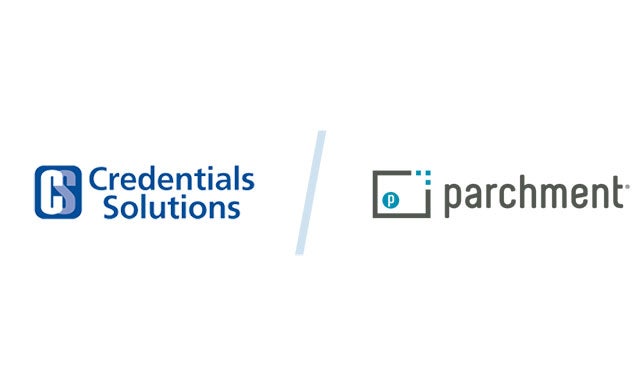
Higher Ed
The Next Five Years of Digital Credentialing: Brighter Higher Education Pathways
What do the next five years of digital credentialing look like? Learn how microcredentials, badges, and skills can shape higher education pathways.

With over 40 years of combined experience serving educators, the Credentials and Parchment merger will provide high schools, universities, and employers with a partner focused on the continued modernization of academic credential exchange, including transcripts, diplomas, certificates, comprehensive learner records, and badges. The new organization will focus on delivering more extensive support of student pathways, exceptional service, and innovation.
What does this mean for my institution?
Continuity of service and long-standing relationships are critically important to our members (customers), so while we are excited about future innovation, you remain our top priority. Our commitment is to provide existing members with the same, or better, level of service as you experience today. It is on this foundation that the rest of our innovation agenda builds.
Why did Credentials and Parchment decide to merge?
The rapid evolution of credential management has made it clear to us that combining our networks, resources, and organizational strengths can better position us to serve our members now and into the future. Our hope and expectation is that the new combined organization will break down barriers in student pathways and accelerate credential innovation in ways neither company could tackle independently. Together, we can address the sector’s mandate to accelerate the transformation of transcripts into machine-readable data, based on open standards, learner managed, and exchangeable across a broad network of organizations.
What should I call the combined company? Credentials Parchment? Parchment Credentials? Parchentials?
While the final determination on the name has not been made, the anticipated new organization will truly be a new one born from the team, technology, and traditions of Credentials and Parchment. We know members may be attached to one name or the other, but to paraphrase Shakespeare, a rose by any other name would still smell as sweet. Right?
Will you continue to support both platforms – Credentials and Parchment?
We are committed to protecting the investment that our members have made in our services by providing continuity. That said, we believe we can quickly deliver more value to admissions offices and other receivers by integrating our two technology platforms. Our goal is to ultimately support all members with a single, modern platform that honors the distinct strengths we know exist in each today. We commit to providing more information no later than AACRAO’s 2020 annual meeting in April.
How will the combined company operate and what does it mean for the people I enjoy working with?
The new organization will continue to be a people-oriented company that is mission driven, with a focus on innovating credential exchange, while maintaining the highest level of customer service. The joint company will bring together 220 people that have been working every day to achieve each company’s mission in partnership with our members. While there may be shifts in the specific individual you work with, continuity, when possible, will be our priority. We will notify your institution promptly if there are any changes to your institution’s main contact.
What does this announcement mean, if anything, for Parchment K12 members, GED, and State Agencies?
Parchment’s work with K12 members is the foundation for all learner pathways. The K12 platform will remain the same, with regular enhancements, as the network experiences today. The benefit of the merger for this audience is the combined network. It will result in a more consistent experience for high school learners as they later engage with their college records through a learner-centric credential profile. When they request and manage their high school transcript with Parchment, they will be well-positioned to continue to collect and manage their credentials in college and beyond using the same platform. Their important academic records will be centrally collected, stacked, and verified, resulting in a more comprehensive story of their lifelong learning experiences.
What innovation trends will the new organization focus on?
Our long-term goal is a single, modern platform. The timing and detail of how we get there will be defined in the coming months. Once realized, the benefits to our community will include a roadmap with a focus on these five market trends:
Will I be able to receive transcripts from both services through one account?
This is the first milestone we will start working toward on day one. Our entire network benefits from being able to centralize the collection of credentials, resulting in major efficiencies and fast admissions decisions for learners. As we innovate and expand our service offering, we will actively keep the community up to speed with available functionality.
When will I be able to receive transcripts in machine-readable data formats and what formats will be supported?
Machine-readable transcript data will quickly follow the push for an integrated Receive experience. Why? Because data unlocks many other important areas of credential management. After you accomplish the first step of bringing credentials securely online, you’re able to address how transcript data enables innovation in the form and function of traditional credentials. Data unlocks both the format one is able to produce, as well as the way that information is consumed and leveraged along student pathways.
Credentials and Parchment both have long track records of delivering transcript data in the PESC XML and SPEEDE EDI transcript standards. Both companies have been engaged in PESC’s EdExchange initiative. And Parchment has been an active participant in IMS Global’s credentials-related standards efforts.
Who should I contact if I have additional questions, concerns, or feedback?
The voice of our community is crucial to our continued success and partnership, so we want to hear from you. We encourage you to use the form below to submit your questions, so we can accurately route them and get you an answer as quickly as possible.
